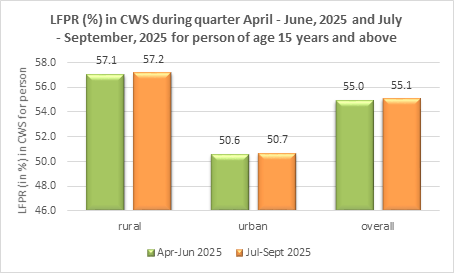PERIODIC LABOUR FORCE SURVEY (PLFS) Quarterly Bulletin July – September, 2025

IN NEWS
Periodic Labour Force Survey (PLFS) Quarterly Bulletin (July–September 2025), released by the National Statistical Office (NSO), Ministry of Statistics and Programme Implementation (MoSPI), shows a continued improvement in labour market indicators—notably a rise in female labour force participation, a decline in unemployment rates, and modest gains in urban salaried employment.
ANALYSIS
- Overall Labour Force Participation Rate (LFPR):
- LFPR among persons aged 15 years and above rose slightly to 55.1% during July–September 2025 from 55.0% in April–June 2025.
- Both rural (57.1% → 57.2%) and urban (50.6% → 50.7%) areas recorded marginal improvements, reflecting steady participation in the labour market.
- Female Labour Force Participation Rate (LFPR):
- Female LFPR increased to 33.7% in July–September 2025 from 33.4% in the previous quarter.
- The improvement was largely driven by rural areas where female LFPR moved up from 37.0% to 37.5%.
- The data suggests a sustained upward momentum in women’s economic participation.
- Worker Population Ratio (WPR):
- The overall WPR for persons aged 15 years and above rose to 52.2% in July–September 2025 from 52.0% in April–June 2025.
- The rise was driven by higher female participation, particularly in rural areas.
- Female WPR increased from 31.6% to 32.0% over the same period, indicating gradual workforce integration.
- Unemployment Rate (UR):
- The overall UR declined to 5.2% during July–September 2025 from 5.4% in the previous quarter.
- Rural UR dropped from 4.8% to 4.4%, reflecting improved rural employment opportunities.
- Urban UR showed a slight rise—6.1% to 6.2% for males and 8.9% to 9.0% for females—indicating uneven recovery trends.
- Employment Composition:
- Rural Sector: Share of self-employed workers increased from 60.7% to 62.8%, showing growing rural entrepreneurship and informal activity.
- Urban Sector: Regular wage/salaried employment improved modestly from 49.4% to 49.8%, suggesting stable job creation in organized sectors.
- Sectoral Distribution:
- Rural Areas: Share of employment in agriculture increased from 53.5% to 57.7%, mainly due to Kharif operations during the monsoon period.
- Urban Areas: Share of workers in the tertiary sector rose slightly from 61.7% to 62.0%, showing continued dominance of services in urban employment.
- Overall Workforce Estimate:
- Total employed persons aged 15 years and above: 56.2 crore
- Male: 39.6 crore
- Female: 16.6 crore
- Total employed persons aged 15 years and above: 56.2 crore
STATIC PART
- Periodic Labour Force Survey (PLFS):
- Conducted by National Statistical Office (NSO) under MoSPI.
- Introduced in April 2017, it replaced the earlier Employment-Unemployment Survey of the NSSO.
- Provides data on employment, unemployment, and labour force participationbased on two measures:
- Usual Status (ps+ss) – considering a longer reference period.
- Current Weekly Status (CWS) – based on activity during the 7 days preceding the survey.
- Revised Methodology (Effective January 2025):
- Enables monthly and quarterly estimates of labour market indicators for both rural and urban areas under the CWS framework.
- Earlier PLFS Quarterly Bulletins (till December 2024) covered only urban areas; post-April–June 2025, data includes rural estimates as well.
- Key Indicators:
- LFPR: Proportion of working-age population in the labour force.
- WPR: Ratio of employed persons to total population.
- UR: Percentage of unemployed persons in the labour force.
- Policy Significance:
- Helps assess job creation trends, female participation, and sectoral employment shifts.
- Supports evidence-based policy formulation for employment generation, skill development, and gender inclusion in the labour market.

Updated – 10 Nov 2025 ; 4:30 PM | PIB